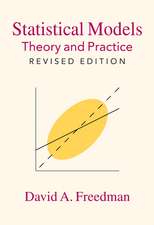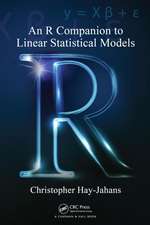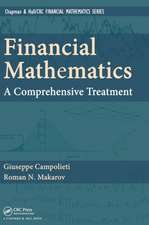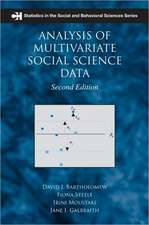Graphical Data Analysis with R: Chapman &Hall/CRC The R Series
Autor Antony Unwinen Limba Engleză Paperback – 21 ian 2023
Graphical Data Analysis with R shows you what information you can gain from graphical displays. The book focuses on why you draw graphics to display data and which graphics to draw (and uses R to do so). All the datasets are available in R or one of its packages and the R code is available at rosuda.org/GDA.
Graphical data analysis is useful for data cleaning, exploring data structure, detecting outliers and unusual groups, identifying trends and clusters, spotting local patterns, evaluating modelling output, and presenting results. This book guides you in choosing graphics and understanding what information you can glean from them. It can be used as a primary text in a graphical data analysis course or as a supplement in a statistics course. Colour graphics are used throughout.
| Toate formatele și edițiile | Preț | Express |
|---|---|---|
| Paperback (1) | 343.32 lei 3-5 săpt. | +29.07 lei 7-11 zile |
| CRC Press – 21 ian 2023 | 343.32 lei 3-5 săpt. | +29.07 lei 7-11 zile |
| Hardback (1) | 510.28 lei 6-8 săpt. | |
| CRC Press – 20 mai 2015 | 510.28 lei 6-8 săpt. |
Din seria Chapman &Hall/CRC The R Series
-
 Preț: 350.96 lei
Preț: 350.96 lei - 20%
 Preț: 529.96 lei
Preț: 529.96 lei - 20%
 Preț: 424.82 lei
Preț: 424.82 lei -
 Preț: 358.30 lei
Preț: 358.30 lei - 20%
 Preț: 548.69 lei
Preț: 548.69 lei - 8%
 Preț: 490.79 lei
Preț: 490.79 lei - 23%
 Preț: 1327.47 lei
Preț: 1327.47 lei - 8%
 Preț: 453.31 lei
Preț: 453.31 lei -
 Preț: 400.98 lei
Preț: 400.98 lei - 8%
 Preț: 386.32 lei
Preț: 386.32 lei -
 Preț: 389.17 lei
Preț: 389.17 lei -
 Preț: 391.57 lei
Preț: 391.57 lei -
 Preț: 152.12 lei
Preț: 152.12 lei - 8%
 Preț: 491.54 lei
Preț: 491.54 lei - 20%
 Preț: 421.05 lei
Preț: 421.05 lei -
 Preț: 356.63 lei
Preț: 356.63 lei - 8%
 Preț: 418.06 lei
Preț: 418.06 lei -
 Preț: 373.05 lei
Preț: 373.05 lei - 8%
 Preț: 544.64 lei
Preț: 544.64 lei -
 Preț: 359.66 lei
Preț: 359.66 lei - 8%
 Preț: 437.61 lei
Preț: 437.61 lei -
 Preț: 360.29 lei
Preț: 360.29 lei -
 Preț: 260.53 lei
Preț: 260.53 lei - 8%
 Preț: 422.96 lei
Preț: 422.96 lei - 8%
 Preț: 438.87 lei
Preț: 438.87 lei -
 Preț: 356.63 lei
Preț: 356.63 lei - 20%
 Preț: 308.68 lei
Preț: 308.68 lei -
 Preț: 230.57 lei
Preț: 230.57 lei - 17%
 Preț: 271.58 lei
Preț: 271.58 lei - 15%
 Preț: 513.32 lei
Preț: 513.32 lei -
 Preț: 392.33 lei
Preț: 392.33 lei - 9%
 Preț: 835.78 lei
Preț: 835.78 lei - 20%
 Preț: 1329.88 lei
Preț: 1329.88 lei - 22%
 Preț: 447.69 lei
Preț: 447.69 lei - 24%
 Preț: 566.03 lei
Preț: 566.03 lei - 31%
 Preț: 842.05 lei
Preț: 842.05 lei - 18%
 Preț: 1082.45 lei
Preț: 1082.45 lei - 20%
 Preț: 578.11 lei
Preț: 578.11 lei - 26%
 Preț: 1014.74 lei
Preț: 1014.74 lei - 20%
 Preț: 1066.99 lei
Preț: 1066.99 lei - 25%
 Preț: 531.55 lei
Preț: 531.55 lei
Preț: 343.32 lei
Nou
Puncte Express: 515
Preț estimativ în valută:
65.70€ • 67.87$ • 54.68£
65.70€ • 67.87$ • 54.68£
Carte disponibilă
Livrare economică 04-18 martie
Livrare express 18-22 februarie pentru 39.06 lei
Preluare comenzi: 021 569.72.76
Specificații
ISBN-13: 9781032477312
ISBN-10: 1032477318
Pagini: 310
Ilustrații: 135
Dimensiuni: 156 x 234 x 18 mm
Greutate: 0.62 kg
Ediția:1
Editura: CRC Press
Colecția CRC Press
Seria Chapman &Hall/CRC The R Series
Locul publicării:Boca Raton, United States
ISBN-10: 1032477318
Pagini: 310
Ilustrații: 135
Dimensiuni: 156 x 234 x 18 mm
Greutate: 0.62 kg
Ediția:1
Editura: CRC Press
Colecția CRC Press
Seria Chapman &Hall/CRC The R Series
Locul publicării:Boca Raton, United States
Public țintă
Professional Practice & DevelopmentCuprins
Setting the Scene. Brief Review of the Literature and Background Materials. Examining Continuous Variables. Displaying Categorical Data. Looking for Structure: Dependency Relationships and Associations. Investigating Multivariate Continuous Data. Studying Multivariate Categorical Data. Getting an Overview. Graphics and Data Quality: How Good Are the Data?. Comparisons, Comparisons, Comparisons. Graphics for Time Series. Ensemble Graphics and Case Studies. Some Notes on Graphics with R. Summary. References. Indices.
Notă biografică
Antony Unwin is a professor of computer-oriented statistics and data analysis at the University of Augsburg. He is a fellow of the American Statistical Society, co-author of Graphics of Large Datasets, and co-editor of the Handbook of Data Visualization. His research focuses on data visualisation, especially in interactive graphics. His research group has developed several pieces of interactive graphics software and written packages for R.
Recenzii
". . . the book follows a learning-by-doing approach.With numerous examples, the author shows how important qualitative aspects of data can be detected by means of simple plots, and how a few simple changes in a graph may uncover relevant information not visible before, setting aside the more technical aspects of plots in R. Still, for each graph, the respective R-code is provided in the book, and complete programme codes for the examples ae available on the book’s webpage. Thus, by copy and paste, one can easily rescale all graphs, change the aspect ratio and apply other modifications to the original plot. This blended-learning approach facilitates exploring the data graphically without requiring too much knowledge of R syntax. This book is therefore well suited for students and novice data analysts who want to learn from examples. It could also supplement theoretical statistics courses, and help statistics teachers in finding suitable graphical displays for various purposes."
—Jasmin Wachter, Universität Klagenfurt
"Overall, the book is a very good introduction to the practical side of graphical data analysis using R. The presentation of R code and graphics output is excellent, with colours used when required. The book appears to be free of typographical and other errors, and its index is useful. Also, the book is well written and neatly structured. I enjoyed reading the book and can recommend it to anyone who wants to learn more about their data through graphics using R. It will also be a valuable asset for a library and as part of an undergraduate course in applied statistics."
—Journal of the Royal Statistical Society, Series A
"Throughout, the book follows a learning-by-doing approach. With numerous examples, the author shows how important qualitative aspects of data can be detected by means of simple plots, and how a few simple changes in a graph may uncover relevant information not visible before, setting aside the more technical aspects of plots in R. Still, for each graph, the respective R-code is provided in the book, and complete programme codes for the examples ae available on the book’s webpage. … This blended-learning approach facilitates exploring the data graphically without requiring too much knowledge of R syntax. This book is therefore well suited for students and novice data analysts who want to learn from examples. It could also supplement theoretical statistics courses, and help statistics teachers in finding suitable graphical displays for various purposes."
—Statistical Papers, 2017
"… an attractive addition to the current statistical graphics texts as it demonstrates what can be learned through graphs."
—Significance Magazine, February 2016
"… the strength of this book lies in the profound introduction to the topic of graphical data analysis. The comprehensive sectional introductions and overviews along with the ‘how-to’ might well be regarded as the modern update to Tukey’s 1977 landmark book."
—Biometrical Journal, December 2015
"Antony Unwin’s very clever new book … is well written, clearly by a practitioner with wide experience, gives generally good (though sometimes opinionated) advice, and includes R code for nearly all examples, as well as nice collections of additional exercises for each chapter … Beyond the content, Unwin also does an admirable job of conveying enthusiasm for data graphics."
—Journal of Educational and Behavioral Statistics, December 2015
"This text has the potential of bringing sophisticated visualization to a broad audience without resorting to mathematical formalizations or the skills of a graphics artist. It engages the reader with interesting graphics right from the start and overall is clear and unintimidating. Code for all examples is provided in the text and is available on a supporting website. What’s more, the code works as is, rather unusual and refreshing."
—Journal of Statistical Software, November 2015
"For statisticians and experts in data analysis, the book is without doubt the new reference work on the subject."
—Thomas Rahlf, datendesign-r.de
...would also be an excellent suggested additional reading for a pragmatic graphical data analysis-oriented course.
—Reijo Sund, Centre for Research Methods, University of Helsinki
". . . the book follows a learning-by-doing approach.With numerous examples, the author shows how important qualitative aspects of data can be detected by means of simple plots, and how a few simple changes in a graph may uncover relevant information not visible before, setting aside the more technical aspects of plots in R. Still, for each graph, the respective R-code is provided in the book, and complete programme codes for the examples ae available on the book’s webpage. Thus, by copy and paste, one can easily rescale all graphs, change the aspect ratio and apply other modifications to the original plot. This blended-learning approach facilitates exploring the data graphically without requiring too much knowledge of R syntax. This book is therefore well suited for students and novice data analysts who want to learn from examples. It could also supplement theoretical statistics courses, and help statistics teachers in finding suitable graphical displays for various purposes."
—Jasmin Wachter, Universität Klagenfurt
"This book is a great reference book for a researcher or a consultant to get inspiration about different ways of exploring the features in the analyzed data. … the book increases the awareness of the observers’ perception of the data displayed in graphs with different graphical choices….The approach to presenting R code is just one example of very careful organization of the content of the book, allowing it to supply a broad range of ideas without rendering the book heavy. Other proof of clever organization includes well-targeted use of example datasets and the occasional use of succinctly written and well-presented lists containing useful commentary."
—Journal of the American Statistical Association
"Throughout, the book follows a learning-by-doing approach. With numerous examples, the author shows how important qualitative aspects of data can be detected by means of simple plots, and how a few simple changes in a graph may uncover relevant information not visible before, setting aside the more technical aspects of plots in R. Still, for each graph, the respective R-code is provided in the book, and complete programme codes for the examples ae available on the book’s webpage. … This blended-learning approach facilitates exploring the data graphically without requiring too much knowledge of R syntax. This book is therefore well suited for students and novice data analysts who want to learn from examples. It could also supplement theoretical statistics courses, and help statistics teachers in finding suitable graphical displays for various purposes."
—Statistical Papers, 2017
"Overall, the book is a very good introduction to the practical side of graphical data analysis using R. The presentation of R code and graphics output is excellent, with colours used when required. The book appears to be free of typographical and other errors, and its index is useful. Also, the book is well written and neatly structured. I enjoyed reading the book and can recommend it to anyone who wants to learn more about their data through graphics using R. It will also be a valuable asset for a library and as part of an undergraduate course in applied statistics."
—Journal of the Royal Statistical Society, Series A
"… an attractive addition to the current statistical graphics texts as it demonstrates what can be learned through graphs."
—Significance Magazine, February 2016
"… the strength of this book lies in the profound introduction to the topic of graphical data analysis. The comprehensive sectional introductions and overviews along with the ‘how-to’ might well be regarded as the modern update to Tukey’s 1977 landmark book."
—Biometrical Journal, December 2015
"Antony Unwin’s very clever new book … is well written, clearly by a practitioner with wide experience, gives generally good (though sometimes opinionated) advice, and includes R code for nearly all examples, as well as nice collections of additional exercises for each chapter … Beyond the content, Unwin also does an admirable job of conveying enthusiasm for data graphics."
—Journal of Educational and Behavioral Statistics, December 2015
"This text has the potential of bringing sophisticated visualization to a broad audience without resorting to mathematical formalizations or the skills of a graphics artist. It engages the reader with interesting graphics right from the start and overall is clear and unintimidating. Code for all examples is provided in the text and is available on a supporting website. What’s more, the code works as is, rather unusual and refreshing."
—Journal of Statistical Software, November 2015
"For statisticians and experts in data analysis, the book is without doubt the new reference work on the subject."
—Thomas Rahlf, datendesign-r.de
...would also be an excellent suggested additional reading for a pragmatic graphical data analysis-oriented course.
—Reijo Sund, Centre for Research Methods, University of Helsinki
—Jasmin Wachter, Universität Klagenfurt
"Overall, the book is a very good introduction to the practical side of graphical data analysis using R. The presentation of R code and graphics output is excellent, with colours used when required. The book appears to be free of typographical and other errors, and its index is useful. Also, the book is well written and neatly structured. I enjoyed reading the book and can recommend it to anyone who wants to learn more about their data through graphics using R. It will also be a valuable asset for a library and as part of an undergraduate course in applied statistics."
—Journal of the Royal Statistical Society, Series A
"Throughout, the book follows a learning-by-doing approach. With numerous examples, the author shows how important qualitative aspects of data can be detected by means of simple plots, and how a few simple changes in a graph may uncover relevant information not visible before, setting aside the more technical aspects of plots in R. Still, for each graph, the respective R-code is provided in the book, and complete programme codes for the examples ae available on the book’s webpage. … This blended-learning approach facilitates exploring the data graphically without requiring too much knowledge of R syntax. This book is therefore well suited for students and novice data analysts who want to learn from examples. It could also supplement theoretical statistics courses, and help statistics teachers in finding suitable graphical displays for various purposes."
—Statistical Papers, 2017
"… an attractive addition to the current statistical graphics texts as it demonstrates what can be learned through graphs."
—Significance Magazine, February 2016
"… the strength of this book lies in the profound introduction to the topic of graphical data analysis. The comprehensive sectional introductions and overviews along with the ‘how-to’ might well be regarded as the modern update to Tukey’s 1977 landmark book."
—Biometrical Journal, December 2015
"Antony Unwin’s very clever new book … is well written, clearly by a practitioner with wide experience, gives generally good (though sometimes opinionated) advice, and includes R code for nearly all examples, as well as nice collections of additional exercises for each chapter … Beyond the content, Unwin also does an admirable job of conveying enthusiasm for data graphics."
—Journal of Educational and Behavioral Statistics, December 2015
"This text has the potential of bringing sophisticated visualization to a broad audience without resorting to mathematical formalizations or the skills of a graphics artist. It engages the reader with interesting graphics right from the start and overall is clear and unintimidating. Code for all examples is provided in the text and is available on a supporting website. What’s more, the code works as is, rather unusual and refreshing."
—Journal of Statistical Software, November 2015
"For statisticians and experts in data analysis, the book is without doubt the new reference work on the subject."
—Thomas Rahlf, datendesign-r.de
...would also be an excellent suggested additional reading for a pragmatic graphical data analysis-oriented course.
—Reijo Sund, Centre for Research Methods, University of Helsinki
". . . the book follows a learning-by-doing approach.With numerous examples, the author shows how important qualitative aspects of data can be detected by means of simple plots, and how a few simple changes in a graph may uncover relevant information not visible before, setting aside the more technical aspects of plots in R. Still, for each graph, the respective R-code is provided in the book, and complete programme codes for the examples ae available on the book’s webpage. Thus, by copy and paste, one can easily rescale all graphs, change the aspect ratio and apply other modifications to the original plot. This blended-learning approach facilitates exploring the data graphically without requiring too much knowledge of R syntax. This book is therefore well suited for students and novice data analysts who want to learn from examples. It could also supplement theoretical statistics courses, and help statistics teachers in finding suitable graphical displays for various purposes."
—Jasmin Wachter, Universität Klagenfurt
"This book is a great reference book for a researcher or a consultant to get inspiration about different ways of exploring the features in the analyzed data. … the book increases the awareness of the observers’ perception of the data displayed in graphs with different graphical choices….The approach to presenting R code is just one example of very careful organization of the content of the book, allowing it to supply a broad range of ideas without rendering the book heavy. Other proof of clever organization includes well-targeted use of example datasets and the occasional use of succinctly written and well-presented lists containing useful commentary."
—Journal of the American Statistical Association
"Throughout, the book follows a learning-by-doing approach. With numerous examples, the author shows how important qualitative aspects of data can be detected by means of simple plots, and how a few simple changes in a graph may uncover relevant information not visible before, setting aside the more technical aspects of plots in R. Still, for each graph, the respective R-code is provided in the book, and complete programme codes for the examples ae available on the book’s webpage. … This blended-learning approach facilitates exploring the data graphically without requiring too much knowledge of R syntax. This book is therefore well suited for students and novice data analysts who want to learn from examples. It could also supplement theoretical statistics courses, and help statistics teachers in finding suitable graphical displays for various purposes."
—Statistical Papers, 2017
"Overall, the book is a very good introduction to the practical side of graphical data analysis using R. The presentation of R code and graphics output is excellent, with colours used when required. The book appears to be free of typographical and other errors, and its index is useful. Also, the book is well written and neatly structured. I enjoyed reading the book and can recommend it to anyone who wants to learn more about their data through graphics using R. It will also be a valuable asset for a library and as part of an undergraduate course in applied statistics."
—Journal of the Royal Statistical Society, Series A
"… an attractive addition to the current statistical graphics texts as it demonstrates what can be learned through graphs."
—Significance Magazine, February 2016
"… the strength of this book lies in the profound introduction to the topic of graphical data analysis. The comprehensive sectional introductions and overviews along with the ‘how-to’ might well be regarded as the modern update to Tukey’s 1977 landmark book."
—Biometrical Journal, December 2015
"Antony Unwin’s very clever new book … is well written, clearly by a practitioner with wide experience, gives generally good (though sometimes opinionated) advice, and includes R code for nearly all examples, as well as nice collections of additional exercises for each chapter … Beyond the content, Unwin also does an admirable job of conveying enthusiasm for data graphics."
—Journal of Educational and Behavioral Statistics, December 2015
"This text has the potential of bringing sophisticated visualization to a broad audience without resorting to mathematical formalizations or the skills of a graphics artist. It engages the reader with interesting graphics right from the start and overall is clear and unintimidating. Code for all examples is provided in the text and is available on a supporting website. What’s more, the code works as is, rather unusual and refreshing."
—Journal of Statistical Software, November 2015
"For statisticians and experts in data analysis, the book is without doubt the new reference work on the subject."
—Thomas Rahlf, datendesign-r.de
...would also be an excellent suggested additional reading for a pragmatic graphical data analysis-oriented course.
—Reijo Sund, Centre for Research Methods, University of Helsinki
Descriere
This book focuses on why one draws graphics to display data and which graphics to draw (and uses R to do so). Graphical data analysis is useful for data cleaning, exploring data structure, detecting outliers and unusual groups, identifying trends and clusters, spotting local patterns, evaluating modelling output, and presenting results. All the










